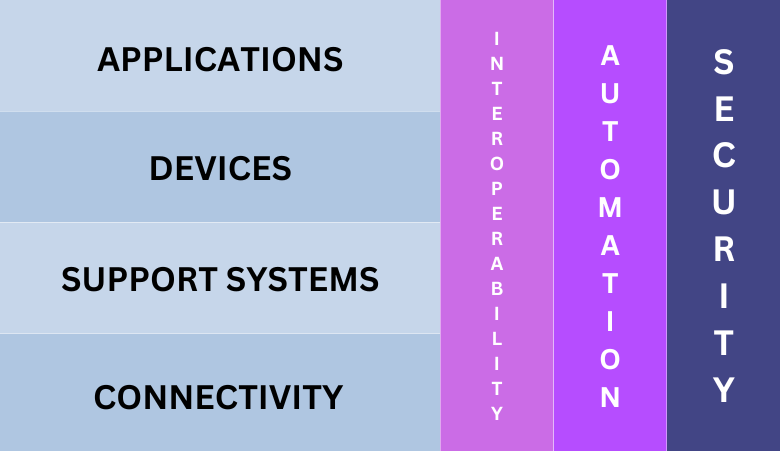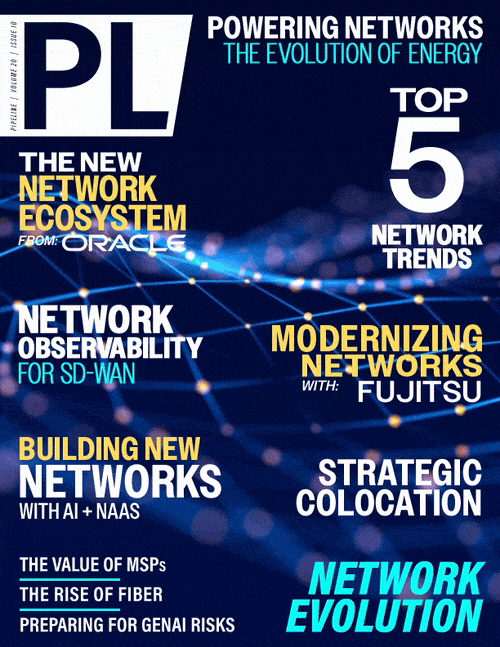Five Tech & Network Megatrends
That Will Shape the Future
By: Daniel Mowinski - Pipeline, Scott St. John - Pipeline

This century will see an array of new large-scale technology use cases. Relevant breakthroughs and their monetization models are fast becoming apparent in both the enterprise and consumer spheres.
At the core of the advances set to shape the technological future is the fully autonomous enterprise — self-operating, surpassing human intelligence, and wrapped in a web of security and regulation. The opportunity for telecom providers, technical pioneers, and consumer-facing enterprises lies in building and implementing a new technology stack that is capable of powering innovation forward.
The new Innovation Stack has seven fundamental functional areas that encompass front-end applications, connected devices, support systems (e.g. B/OSS), connectivity, interoperability (e.g. APIs), automation (e.g. AI), and security (encompassing compliance), as encapsulated in the graphic below (see Figure 1, below).
Each of these functional areas are essential for the fully autonomous enterprise and the innovations of tomorrow. Basic network and tech commodities as standalone offerings or point solutions,
while integral to the stack, are only one facet of the overarching technical shift that is well underway across many industries. Those companies that succeed in the future will incorporate
multiple layers of these functional areas – and perhaps the entire stack – into their offerings. And the demand will precipitate end-to-end service packages that cater to complex connectivity,
security, and automation needs. This is the foundation on which future innovations will be built, and the areas in which the top trends detailed below will have the most impact.

Figure 1 - The Innovation Stack of the Future
Yet the move towards full autonomy and an ubiquitously connected, post-human society poses profound ethical, operational, and social questions. All involved must address these key considerations to determine how to best capitalize on the host of opportunities that this fundamental change offers.
Trend 1: The Fully Autonomous Enterprise
Looking at the Automation Layer first, it encompasses key technologies for the integration of data silos from other layers, with security and automation technologies like AI, blockchain, Gen AI, RPA, and XML baked in. Of course, this must interoperate between other layers of the Innovation Stack, such as with the Device Layer, through APIs and intelligent IoT gateways. This makes it possible to create fully autonomous enterprises and offer mutlimodal inputs at both the strategic and operational levels. For example, the AI autonomous agent, which can match (and often outmatch) humans in domains like trading and customer service.In The Coming Wave, futurist Mustafa Suleyman writes, “In this paradigm, there is no need for a human to laboriously define the manner in which a task should take place. Instead, we just specify a high-level goal and rely on a machine to figure out the optimal way of getting there. Keeping humans “in the loop,” as the saying goes, is desirable, but optional.
A picture of what the fully autonomous enterprise will look like is emerging. Imagine a scenario in which self-driving trucks — already in operation in certain European “confined zones,” such as mines — deliver materials for storage in a smart warehouse. These materials are then transported by unloading robots — such as the well-known Stretch from Boston Dynamics — to self-governing production lines.
The whole system is overseen by an auto-troubleshooting, self-optimizing AI and a business process automation (BPA) model. Generative AI advertises the products and handles multivariate testing, marketing, and customer support. On the delivery end, purchases are fulfilled by autonomous warehouses and delivery networks like those offered by Prologis and Amazon. Meanwhile, eXtensible Markup Language (XML) and blockchain provide the basis for compliance and intelligent contracts.
The pace of change is also likely accelerate as enterprises are under pressure to pursue adoption to improve margins and increase operational efficiency. The C-suite is keenly aware that robots don’t sue, get sick, or join unions. AI systems don’t ask for raises and aren’t concerned about work-life balance. They just work, 24-hours a day, 7 days a weeks, 365 days a year.
The fully autonomous enterprise is already a reality in some places and is beginning to change the face of global commerce. Telecom and technology providers have an incredible opportunity to create new offerings and develop widespread use cases that create, or cater to the fully autonomous enterprise.



















